It's waiting for you: The most successful Aurora Photo Tour on Earth! 100% success rate 4 years in a row and winner of the TripAdvisor Certificate of Excellence Award. Join LapplandMedia's aurora tours in Abisko, Swedish Lapland! | | | STRONGEST FLARE OF 2016: Sunspot complex AR2565-AR2567 erupted on July 23rd, twice, producing two strong solar flares in quick succession. The first @ 0211 UT registered M5 on the Richter Scale of Flares. The second @ 0516 UT registered M7.6, making it the strongest flare of 2016 so far. NASA's Solar Dynamics Observatory recorded the blast: 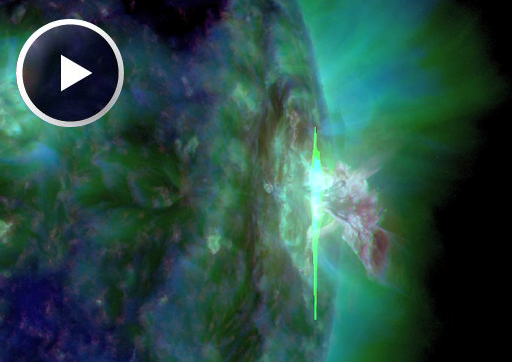
Pulses of radiation from the two flares ionized the top of Earth's atmosphere, causing a blackout of shortwave radio transmissions over the Pacific side of Earth. These maps from NOAA show the frequencies and territories affected. People who might have noticed the fading signals include ham radio operators, mariners and aviators. The explosions hurled an impressive CME into space: movie. The cloud is not heading directly for Earth. However, there is a slim chance it could deliver a glancing blow to our planet's magnetic field in the days ahead. NOAA analysts are modeling the CME to evaluate this possibility. Stay tuned for updates. Realtime Space Weather Photo Gallery WHERE NO DUCK HAS GONE BEFORE: Yes, that really is a Vulcan rubber duck! The students of Earth to Sky Calculus flew the pointy-eared water bird to the stratosphere on July 19, 2016, as part of their ongoing program to monitor cosmic rays in the stratosphere. Here he is at the apex of the flight, 109,580 ft: 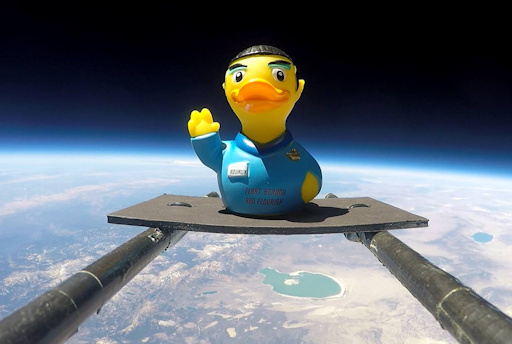
"Mr Squawk" hitchhiked on a helium balloon payload that carried an array of X-ray/gamma-ray sensors. By launching these sensors 3 or 4 times a month, the students have shown that cosmic rays are intensifying--a trend that affects mountain climbers, air travelers, high-altitude drones and astronauts on the International Space Station. This research is crowd funded. Would you like to support it? Buy a duck! Edge of Space Vulcan Ducks are now available in the Earth to Sky Store. THE SPHERICAL MILKY WAY: The Milky Way is beautiful. The Milky Way in 3D ... it's sublime. Last week on the island of La Palma, astrophotographers Karoline Mrazek and Erwin Matys used a Ricoh Theta S camera to photograph our own galaxy with a spherical lens. To see their results, click on the "theta" symbol: 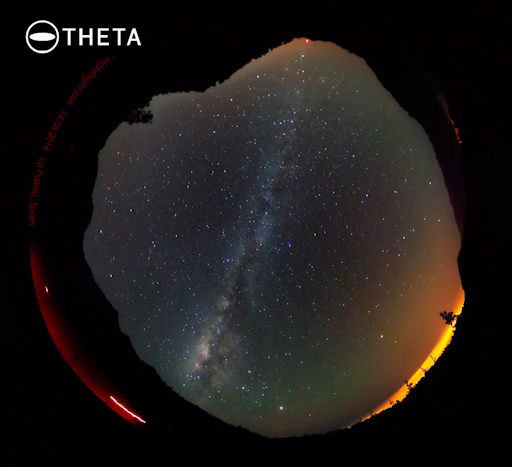
"The interactive spherical image shows the bright galactic center above the pitch black volcanic landscape of La Palma," says Mrazek and Matys. "The full band of the Milky Way is clearly visible as it crosses the zenith." "This proves that it is possible to shoot low-light celestial objects such as the milky way and the zodiacal light with the Theta S. We did 25 exposures of 60 seconds at ISO 800 each for the sky and for the landscape. The individual images were stacked with Deep Sky Stacker and the two stacks were combined with Photoshop."
Mrazek and Matys are founding members of the astrophotography group project nightflight, and they've been testing the Ricoh Theta S in many settings for night-sky photography. Their complete report on spherical astrophotography is highly recommended. Read it here. AFTER THE STORM, MAMMATUS CLOUDS: Yesterday, a severe thunderstorm swept through St Claude, Manitoba, drenching the landscape and cutting power to residents. "While waiting for power to be restored, I noticed these cloud formations drifting serenely overhead," reports Paul Moffat. "It seemed to make the storm's fury worthwhile." 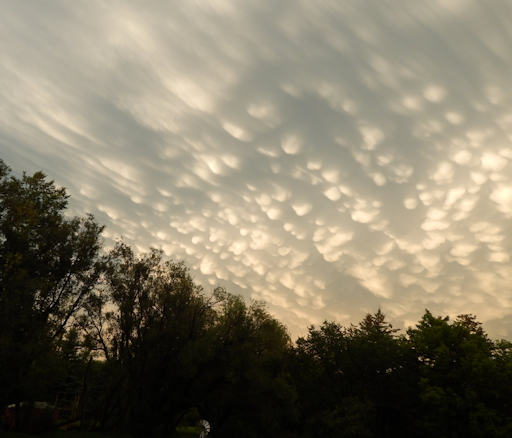
These are mammatus clouds. Named for their resemblance to a cow's underbelly, they often appear around the unstable edges of severe thunderstorms. Researchers have called mammatus clouds an "intriguing enigma," because they have not been studied as much as other clouds, and there is much uncertainty about how they form. Photographers and artists have long valued mammatus clouds for their strangely beautiful appearance. Indeed, Gedzelman (1989) notes that the pendulous lobes appear in paintings as early as the 1500s. Mammatus clouds often go unnoticed because potential observers have been chased indoors by the rain. If you are one of them, go back outside when the downpour stops; you could witness a beautiful mystery in the sky. Realtime Space Weather Photo Gallery
Realtime Aurora Photo Gallery
Realtime Noctilucent Cloud Photo Gallery
Realtime Sprite Photo Gallery Every night, a network of NASA all-sky cameras scans the skies above the United States for meteoritic fireballs. Automated software maintained by NASA's Meteoroid Environment Office calculates their orbits, velocity, penetration depth in Earth's atmosphere and many other characteristics. Daily results are presented here on Spaceweather.com. On Jul. 23, 2016, the network reported 24 fireballs.
(22 sporadics, 1 Southern delta Aquariid, 1 July Pegasid)  In this diagram of the inner solar system, all of the fireball orbits intersect at a single point--Earth. The orbits are color-coded by velocity, from slow (red) to fast (blue). [Larger image] [movies] Potentially Hazardous Asteroids ( PHAs) are space rocks larger than approximately 100m that can come closer to Earth than 0.05 AU. None of the known PHAs is on a collision course with our planet, although astronomers are finding new ones all the time. On July 23, 2016 there were potentially hazardous asteroids. Notes: LD means "Lunar Distance." 1 LD = 384,401 km, the distance between Earth and the Moon. 1 LD also equals 0.00256 AU. MAG is the visual magnitude of the asteroid on the date of closest approach. | | Cosmic Rays in the Atmosphere | | Situation Report -- Oct. 30, 2015 | Stratospheric Radiation (+37o N) | | Cosmic ray levels are elevated (+6.1% above the Space Age median). The trend is flat. Cosmic ray levels have increased +0% in the past month. | | Sept. 06: 4.14 uSv/hr (414 uRad/hr) | | Sept. 12: 4.09 uSv/hr (409 uRad/hr) | | Sept. 23: 4.12 uSv/hr (412 uRad/hr) | | Sept. 25: 4.16 uSv/hr (416 uRad/hr) | | Sept. 27: 4.13 uSv/hr (413 uRad/hr) | | Oct. 11: 4.02 uSv/hr (402 uRad/hr) | | Oct. 22: 4.11 uSv/hr (411 uRad/hr) | These measurements are based on regular space weather balloon flights: learn more. Approximately once a week, Spaceweather.com and the students of Earth to Sky Calculus fly "space weather balloons" to the stratosphere over California. These balloons are equipped with radiation sensors that detect cosmic rays, a surprisingly "down to Earth" form of space weather. Cosmic rays can seed clouds, trigger lightning, and penetrate commercial airplanes. Our measurements show that someone flying back and forth across the continental USA, just once, can absorb as much ionizing radiation as 2 to 5 dental X-rays. For example, here is the data from a flight on Oct. 22, 2015: 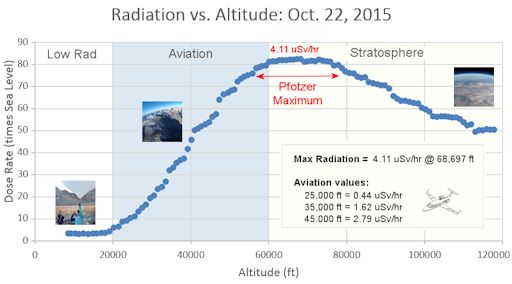
Radiation levels peak at the entrance to the stratosphere in a broad region called the "Pfotzer Maximum." This peak is named after physicist George Pfotzer who discovered it using balloons and Geiger tubes in the 1930s. Radiation levels there are more than 80x sea level. Note that the bottom of the Pfotzer Maximim is near 55,000 ft. This means that some high-flying aircraft are not far from the zone of maximum radiation. Indeed, according to the Oct 22th measurements, a plane flying at 45,000 feet is exposed to 2.79 uSv/hr. At that rate, a passenger would absorb about one dental X-ray's worth of radiation in about 5 hours. The radiation sensors onboard our helium balloons detect X-rays and gamma-rays in the energy range 10 keV to 20 MeV. These energies span the range of medical X-ray machines and airport security scanners. | | The official U.S. government space weather bureau | | | The first place to look for information about sundogs, pillars, rainbows and related phenomena. | | | Researchers call it a "Hubble for the sun." SDO is the most advanced solar observatory ever. | | | 3D views of the sun from NASA's Solar and Terrestrial Relations Observatory | | | Realtime and archival images of the Sun from SOHO. | | | from the NOAA Space Environment Center | | | the underlying science of space weather |  | Tobi -- Proud Supporter of Space Education! |  | Claim your tax refund with this UK tax rebate company and get back your overpaid tax. |  | Enjoy this fabulous range of leather sofas from a leader in the UK sofa manufacturer industry.. | | 
